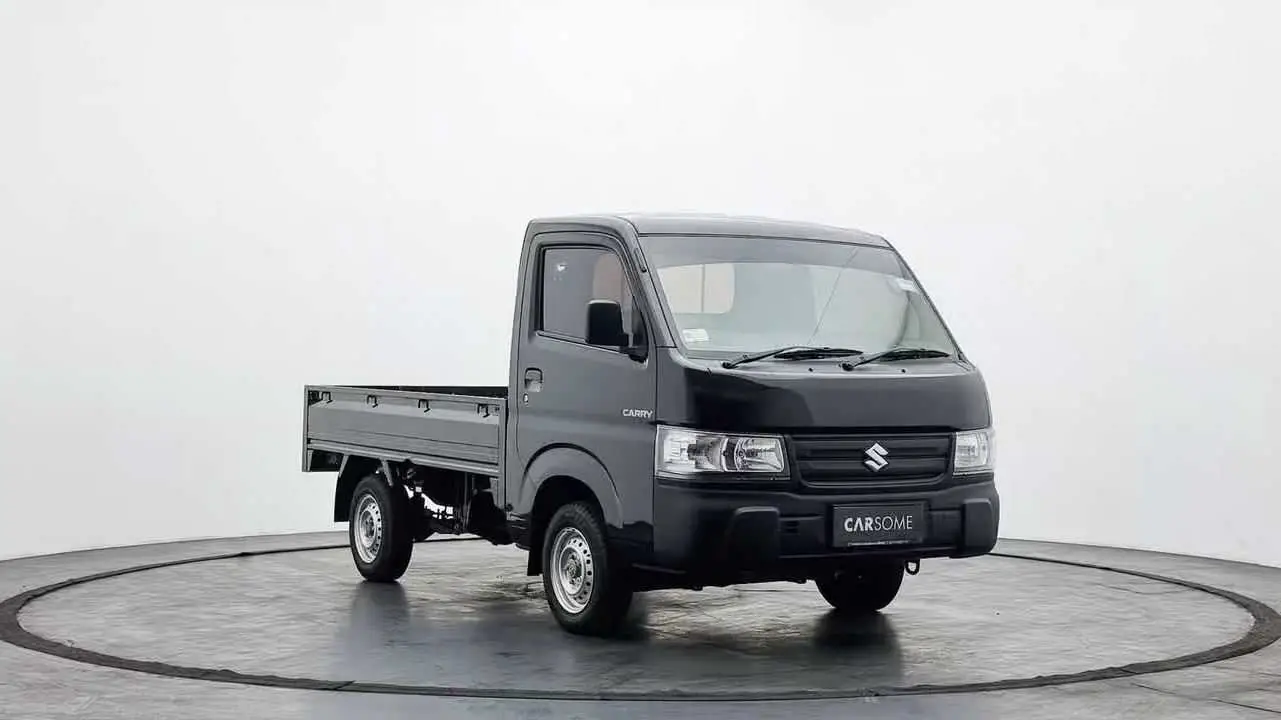2019 Suzuki New CARRY Battery label User Manual
The 2019 Suzuki Carry is a small, multipurpose business vehicle. It has a reliable lead-acid battery that powers its most important functions. This battery makes sure the engine starts reliably and powers many electrical parts that are important for day-to-day activities. The Carry is a great choice for businesses that need to move a lot of cargo quickly because of its small size, large payload capability, and fuel efficiency. It can be set up as a van or a pickup truck, so it can be used for many different things. This model shows how much Suzuki cares about durability. It was made to meet the needs of business use. The car is designed to be useful, but it also has basic comfort and convenience features for the driver. Basically, the 2019 Suzuki Carry is a reliable worker that is made to meet the different needs of businesses looking for a small, capable, and cost-effective way to move goods.
Battery label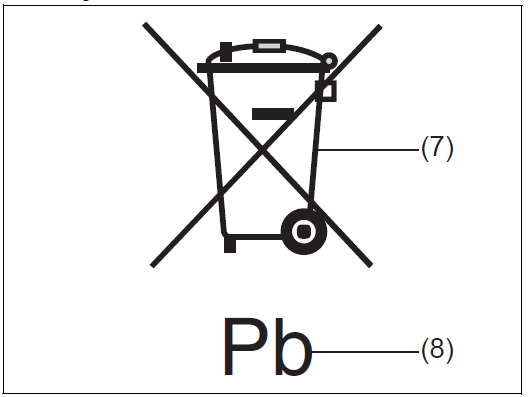
Crossed-out wheeled bin symbol
The chemical symbol of “Pb”
The crossed-out wheeled bin symbol (7) located on the battery label indicates that the used battery should be collected separately from ordinary household trash. The chemical symbol “Pb” (8) indicates the battery contains more than 0.004% lead.
By ensuring the used battery is disposed of or recycled correctly, you will help prevent potential negative consequences for the environment and human health, which could otherwise be caused by inappropriate trash handling of the battery. The recycling of materials will help to conserve natural resources. For more detailed information about disposing of or recycling the used battery, consult a SUZUKI dealer.
Fuses
Your vehicle has three types of fuses, as described below:
Main fuse
The main fuse takes current directly from the battery.
Primary fuses
These fuses are between the main fuse and individual fuses and are for electrical load groups.
Individual fuses
These fuses are for individual electrical circuits.
To remove a fuse, use the fuse puller (1) provided in the relay box cover.
Relay box cover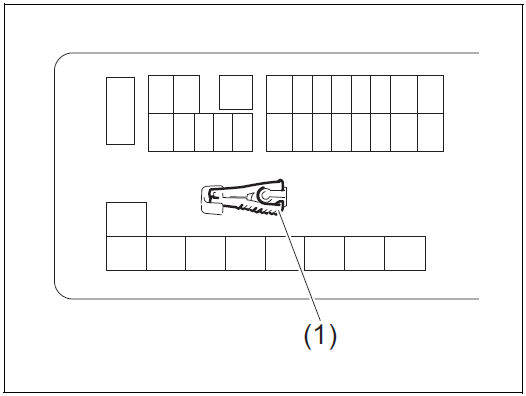

Fuses in Engine Compartment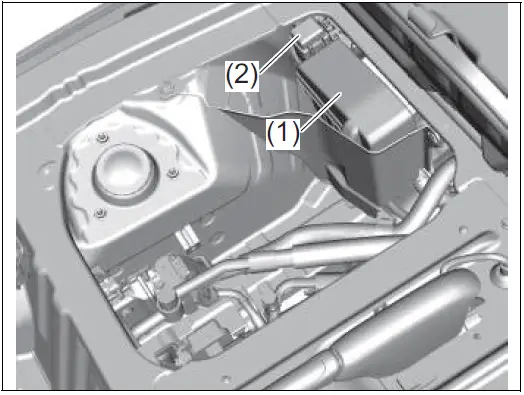
- Relay box No.1
- Relay box no.2 (vehicles with automatic light operation)
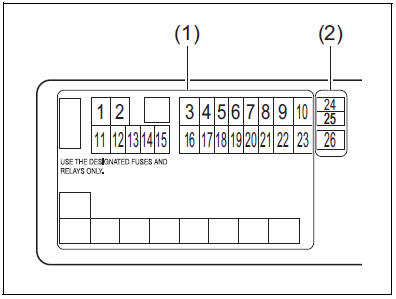
- Relay box No.1
- Relay box no.2 (vehicles with automatic light operation)
| MAIN FUSE / PRIMARY FUSE | ||
| (1) | 40 A | Battery |
| (2) | – | Blank |
| (3) | 40 A | Radiator |
| (4) | 15 A | Horn |
| (5) | 10 A | Compressor |
| (6) | 30 A | ABS SOL |
| (7) | 25 A | Back up |
| (8) | 30 A | Starting motor |
| (9) | 30 A | Ignition switch2 |
| (10) | 40 A | Ignition switch |
| (11) | – | Blank |
| (12) | 15 A | Fuel Injection |
| (13) | – | Blank |
| (14) | 10 A | Stop light |
| (15) | – | Blank |
| (16) | 60 A | Power Steering |
| (17) | – | Blank |
| (18) | 15 A | Headlight (Left) |
| (19) | 25 A | Headlight HI |
| (20) | 15 A | Headlight (Right) |
| (21) | – | Blank |
| (22) | 30 A | Blower motor |
| (23) | 40 A | ABS motor |
| (24) | 15 A | Headlight HI (Right) |
| (25) | 15 A | Headlight HI (Left) |
| (26) | – | Blank |
The main fuse, primary fuses, and some of the individual fuses are located in the engine compartment. If the main fuse blows, no electrical component will function. If a primary fuse blows, no electrical component in the corresponding load group will function. When replacing the main fuse, a primary fuse or an individual fuse, use genuine SUZUKI replacement parts or equivalent for individual fuses. To remove a fuse, use the fuse puller provided in the fuse box. The amperage of each fuse is shown on the back of the fuse box cover.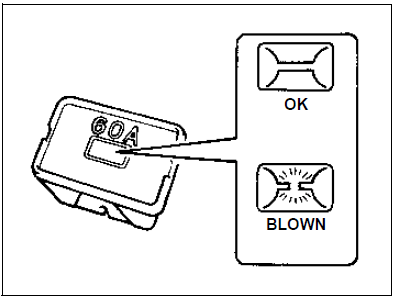
WARNING
If the main fuse or a primary fuse blows have your vehicle inspected by a SUZUKI dealer or a qualified workshop. Always use a genuine SUZUKI replacement. Never use a substitute such as a wire even for a temporary repair, or extensive electrical damage and a fire can result.
NOTE:
Make sure that the fuse box always carries spare fuses.
Fuses under Instrument Panel
Left-hand drive vehicle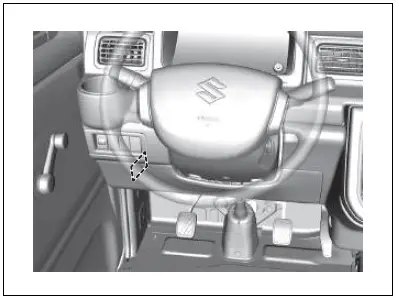
Right-hand drive vehicle
For vehicles without automatic light operation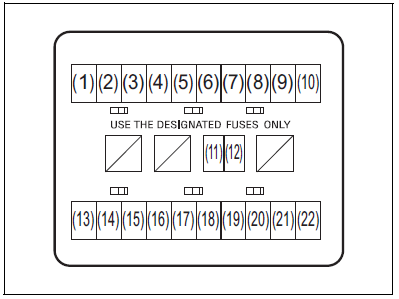
| PRIMARY FUSE | ||
| (1) | 5 A | ST SIG |
| (2) | – | Blank |
| (3) | 5 A | CONT |
| (4) | 10 A | Rear fog light |
| (5) | 10 A | Tail light |
| (6) | 10 A | Hazard light |
| (7) | – | Blank |
| (8) | 5 A | Ignition-2 Signal |
| (9) | 10 A | Washer |
| (10) | 20 A | Front wiper |
| (11) | 10 A | Dome light |
| (12) | 15 A | Radio |
| (13) | 10 A | Meter |
| (14) | 10 A | Ignition-1 Signal |
| (15) | 10 A | Airbag |
| (16) | 5 A | ABS/ESP® control module |
| (17) | 15 A | Ignition |
| (18) | 10 A | Back-up light |
| (19) | – | Blank |
| (20) | – | Blank |
| (21) | 15 A | ACC |
| (22) | 5 A | ST SIG2 |
For vehicles with automatic light operation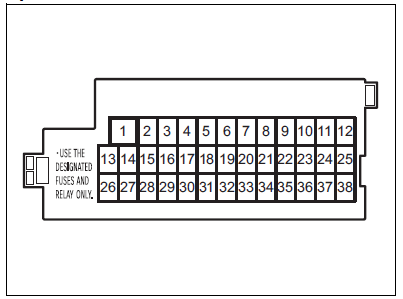
| PRIMARY FUSE | ||
| (1) | – | Blank |
| (2) | 10 A | Meter |
| (3) | 15 A | Ignition |
| (4) | 5 A | Ignition-1 Signal2 |
| (5) | – | Blank |
| (6) | – | Blank |
| (7) | – | Blank |
| (8) | – | Blank |
| (9) | – | Blank |
| (10) | 10 A | Hazard light |
| (11) | – | Blank |
| (12) | 10 A | Rear fog light |
| (13) | 5 A | ABS/ESP® control module |
| (14) | – | Blank |
| (15) | – | Blank |
| (16) | 10 A | Dome light2 |
| (17) | 5 A | Dome |
| (18) | 15 A | Radio |
| (19) | 5 A | CONT |
| (20) | 5 A | Key2 |
| (21) | – | Blank |
| (22) | 5 A | Key |
| (23) | – | Blank |
| (24) | 5 A | Tail light (Left) |
| (25) | 10 A | Tail light |
| (26) | 10 A | Airbag |
| (27) | 10 A | Ignition-1 Signal |
| (28) | 10 A | Back-up light |
| (29) | 5 A | ST SIG2 |
| (30) | – | Blank |
| (31) | – | Blank |
| (32) | 15 A | ACC2 |
| (33) | 5 A | ACC |
| (34) | – | Blank |
| (35) | 5 A | Ignition-2 Signal |
| (36) | 10 A | Washer |
| (37) | 20 A | Front wiper |
| (38) | – | Blank |
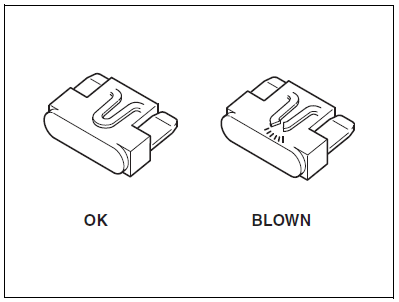
WARNING
Always replace a blown fuse with a fuse of the correct amperage. Never use a substitute such as aluminum foil or wire to replace a blown fuse. If you replace a fuse and the new one blows in a short period of time, you may have a major electrical problem. Have your vehicle inspected immediately by a SUZUKI dealer or a qualified workshop.
FAQ
A battery label is a sticker or tag affixed to a vehicle’s battery that provides important information about the battery, including its specifications, maintenance instructions, and safety warnings.
The type of battery used in a vehicle can vary, but common types include lead-acid batteries, absorbed glass mat (AGM) batteries, and lithium-ion batteries. The specific type used in the Suzuki New Carry would depend on its configuration.
The battery label is typically located on the battery itself or on its casing. It may also be found in the owner’s manual or other documentation provided with the vehicle.
A battery label usually includes information such as the battery’s voltage, capacity (in ampere-hours or Ah), cold cranking amps (CCA), reserve capacity (RC), manufacturing date, and safety instructions.
To find the battery label on your Suzuki New Carry, you should check the battery itself, which is typically located in the engine compartment. Look for a sticker or tag attached to the battery casing.
The voltage rating indicates the electrical potential of the battery (e.g., 12 volts for most vehicle batteries). The capacity rating (in Ah) represents the amount of charge the battery can store.
CCA measures a battery’s ability to start the engine in cold temperatures. Higher CCA ratings indicate better cold-weather performance.
Reserve capacity refers to the number of minutes a fully charged battery can sustain a 25-ampere load before dropping below the minimum voltage required for vehicle operation.
Proper battery maintenance may include keeping the terminals clean, ensuring a secure connection, and periodically checking the electrolyte level (for lead-acid batteries). Refer to the owner’s manual or battery label for specific instructions.
Yes, battery labels typically include safety precautions such as warnings about acid exposure, sparks, and handling instructions.
If your battery label is damaged or missing, it’s a good idea to consult your vehicle’s owner’s manual or contact a Suzuki dealership for information about the appropriate battery specifications and maintenance procedures.
It’s important to replace the battery with one that meets the manufacturer’s specifications and recommendations to ensure proper performance and compatibility with your vehicle.
The lifespan of a vehicle battery can vary depending on usage and environmental conditions. A typical car battery may last 3 to 5 years. It’s a good practice to have it checked regularly and replaced when it no longer holds a charge effectively.
The manufacturing date tells you when the battery was produced. It can be useful in determining the age of the battery and estimating its remaining lifespan.
Yes, it’s essential to recycle old vehicle batteries properly. Many automotive stores and recycling centers accept used batteries for recycling because they contain hazardous materials that need to be disposed of responsibly.
Useful Link
View Full PDF: Suzuki New CARRY 2019 | Auto User Guide
Suzuki New CARRY 2019 Raising Vehicle with Garage Jack User Manual

